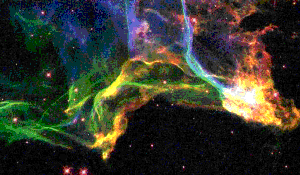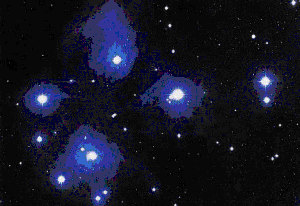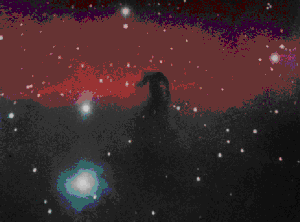 like Bullwinkle."
like Bullwinkle."
CARL SAGAN
He Should Have Lived For Billions & Billions Of Years
by Nicole Chardenet, 12/22/96
"Imagine, if you will," I used to say in college in
perfect imitation of my favorite scientist, "a Cornell astrophysicist who sounds  like Bullwinkle."
like Bullwinkle."
Friday night I received a most upsetting e-mail from James Randi, the former stage magician and now-debunker of pseudo-science, scourge of psychics, alien abductees and faith healers everywhere, and whose mailing list I’m on. "We've lost Carl Sagan, and I can't quite adjust to the fact. When Asimov went, it was bad enough, but now that both these bright lights have gone out, I'm desolated."
"Oh my God, Carl Sagan has died!" I moaned to my Significant Other, also an admirer of the man. We had followed his two-year battle with bone marrow cancer, hoping the man who had done the most to popularize science and critical thinking to an American culture desperately in need of it would live for a little while longer. He was only 62.
I became a follower and fan of Carl Sagan back in college when his popular PBS series, "Cosmos", was rerun on Sunday nights. I always made sure I was home to catch his latest commercial-free hour of history, stars, planets, physics, and speculations on extraterrestrial life. I read all his books, nagged my mother for the book "Cosmos" for Christmas when it came out in 1984, and discussed him with my friends, all of whom were as interested in science as well as science fiction at school. And when we were in a silly mood, we’d play "Dueling Sagans," seeing who could do the best impression of the man with the rich narrative voice.
Carl Sagan was one of the few scientists who could write about complicated scientific issues and make them comprehensible, as well as engaging reading. Some of his books were liberally peppered with glorious full-color photographs of planets, stars, nebulae, dwarf stars, and the Sun taken by Voyager or Pioneer. He wrote extensively about the possibility that life had once existed on Mars, and probably tried harder than any other scientist to search for extraterrestrial life. He never found it in his lifetime, but it is to his credit that as much as he wished to find the evidence—you could feel the desire and the hope in his writings—he never was seduced by the promise but scientifically bankrupt claims of various UFOlogists and alleged alien abductees. Sagan helped launch the SETI project (Search for Extraterrestrial Intelligence), which not only failed to find any signs of life in the universe, but made it crystal-clear that no one was coming around to molest our housewives or rednecks. He was disappointed in his findings, but he was true to science’s aim to seek the truth, as opposed to defining it.
 Sagan was
wildly popular with people all over the world, but he didn’t always tell people what
they wanted to hear. Many people didn’t want to hear that there was no
evidence UFO’s were observing the earth, when it was so much more delightful to think
of alien superhumans leading the human race out of its morass of problems. Sagan
didn’t endear himself to the government when he fought against the militarization of
space; and he was a thorn in side of the Reagan administration and other conservatives
perpetually in denial when he published his theories on nuclear winter, which he said
might well occur even if only a fraction of the nuclear weapons in existence at that time
(1983) were used. Sagan appeared on a scientific panel immediately following the
controversial nuclear war movie "The Day After" and outlined what he thought
would happen and why—ideas which had been incorporated into the movie. He also argued
vehemently against the insanity of Mutually Assured Destruction and against throwing the
huge amounts of money the Reagan administration gave to the Defense Department which was
to eventually drive us deep into the recession of 1993.
Sagan was
wildly popular with people all over the world, but he didn’t always tell people what
they wanted to hear. Many people didn’t want to hear that there was no
evidence UFO’s were observing the earth, when it was so much more delightful to think
of alien superhumans leading the human race out of its morass of problems. Sagan
didn’t endear himself to the government when he fought against the militarization of
space; and he was a thorn in side of the Reagan administration and other conservatives
perpetually in denial when he published his theories on nuclear winter, which he said
might well occur even if only a fraction of the nuclear weapons in existence at that time
(1983) were used. Sagan appeared on a scientific panel immediately following the
controversial nuclear war movie "The Day After" and outlined what he thought
would happen and why—ideas which had been incorporated into the movie. He also argued
vehemently against the insanity of Mutually Assured Destruction and against throwing the
huge amounts of money the Reagan administration gave to the Defense Department which was
to eventually drive us deep into the recession of 1993.
Nor was Sagan popular with conservative Christians, and not just because he was a strong proponent of evolutionary science. They objected to his atheistic stance and his opinion that mankind had to solve its own problems instead of waiting for a savior god to come down and help them out. The truth was, the devout never gave Sagan credit where credit was due: Although he stated in his book "Pale Blue Dot" that he didn’t believe in God or an afterlife because he’d never seen evidence of either, he thought it would be nice to believe there was both. And he often added the words few other scientists had the courage to add when discussing the non-scientific ideas of religion: "Of course, I could be wrong." That’s more than some of his contemporaries, often derided as "fundamentalist skeptics," could claim.
What’s even more ironic was that in many ways, as atheist as he was, a lot of what he believed and taught was far closer to the message of Christ than that of the people who claimed to follow him. He criticized the excesses and abuses of religion, but not the religion itself. And his critiques were never nasty. In all his books, Sagan argued for more tolerance, for diversity, for not hurting each other. He deplored the violence happening all over the globe in the name of politics, religion, or territorialism. He looked to outer space and the cosmos to divert mankind’s attention from its own petty jealousies to discovering What’s Out There. He contemplated black holes as a method to travel to alien worlds in his science fiction novel "Contact", and the political and religious connotations of actually contacting an intelligence greater than our own. He explored the relationship humans had with the cosmos in "The Cosmic Connection," noted that we were really stuck in a tiny, backwater galaxy at the edge of the Milky Way in "Pale Blue Dot", and contemplated the most marvelous organ of the human body in "Broca’s Brain."
Carl Sagan introduced me to my heroine, Hypatia of Alexandria.
Only given a brief, passing mention on one of the "Cosmos"  episodes, the tragic story of Hypatia
really caught my attention and inspired me to find out more about this little-known figure
of ancient history. Alive during the time of St. Augustine and St. Patrick, around the
early part of the fifth century A.D., Hypatia was the young and beautiful and educated
librarian at the famed Library of Alexandria, which by the 3rd century B.C.
housed the world’s largest collection of manuscripts—over half a million.
Hypatia was sought after by many suitors, but turned them all down so she could keep her
independence. She was well-versed in mathematics, history, literature, rhetoric, and
science. It was a dangerous position for a woman of her talents to be in; Christianity had
begun to supplant the ancient pagan ways and the new religion had little tolerance for
women who could not keep their place. Furthermore, although it’s unclear as to
whether Hypatia was a pagan or an atheist, she most certainly refused to convert to the
upstart religion. Nor was Hypatia one to keep her mouth shut; some sources have it that
she used to get into wild public screaming debates with St. Augustine. She annoyed greatly
Cyril, the patriarch of Alexandria.
episodes, the tragic story of Hypatia
really caught my attention and inspired me to find out more about this little-known figure
of ancient history. Alive during the time of St. Augustine and St. Patrick, around the
early part of the fifth century A.D., Hypatia was the young and beautiful and educated
librarian at the famed Library of Alexandria, which by the 3rd century B.C.
housed the world’s largest collection of manuscripts—over half a million.
Hypatia was sought after by many suitors, but turned them all down so she could keep her
independence. She was well-versed in mathematics, history, literature, rhetoric, and
science. It was a dangerous position for a woman of her talents to be in; Christianity had
begun to supplant the ancient pagan ways and the new religion had little tolerance for
women who could not keep their place. Furthermore, although it’s unclear as to
whether Hypatia was a pagan or an atheist, she most certainly refused to convert to the
upstart religion. Nor was Hypatia one to keep her mouth shut; some sources have it that
she used to get into wild public screaming debates with St. Augustine. She annoyed greatly
Cyril, the patriarch of Alexandria.
No one is entirely certain exactly why she was brutally murdered, but legend has it that Cyril organized a Christian mob against her. What is known is that she was dragged from her chariot one day, flayed alive with oyster shells, and her remains burned in a pyre. Needless to say, she’s my hero and a testament to the idea that the barbarians can destroy the flesh, but not the memory or the legacy. And I thank Carl Sagan for introducing me to her.
The last book Sagan wrote was in my opinion, probably his best. James Randi apparently agreed about `The Demon-Haunted World: Science As A Candle In The Dark’. "Many months ago, I received a bound galley of that book, with a cautionary note not to prepare a review based closely upon it, since there were many planned changes due," he wrote. "When I eventually received the final version, I noted many instances where Carl had strengthened his language, upgraded and fortified his adjectives, and in general harded [sic] his language. I had the chilling thought that perhaps he felt this might be his last statement about the pseudoscience, crackpots, frauds, and quacks that he so resented."
Randi was right. The book was probably the most strongly-worded criticism Sagan had ever written about the pseudo-sciences and superstitions that persist even to this enlightened age. He kindly and politely debunked the "Face on Mars"; the alleged remnants of intelligent Martian civilization; alien abductees who claimed transmitters had been planted in their butts but none of whom cared to actually show science any of them; psychics; evangelists who claimed to diagnose ailments through God but who in actuality had tiny radios implanted in their ears while their wives read from a list of medical reports; false sexual and ritual abuse cases brought about by the alleged Repressed Memory Syndrome; and the medieval church’s obsession with witchcraft and sex demons. In the same book, he criticized colleagues who treated people with any spiritual belief as though those people were children; he pointed out how spiritual beliefs can bring about positive changes on the planet; and he argued for scientists to "lighten up" in matters regarding religion, while keeping an eye on the superstitious peasants who would supplant logical thinking and rationalism with rank bogeyman fairy stories.
Sagan also wrote essays for Parade Magazine. One dealt with the possibility of extraterrestrial life, always a favorite subject of his. Another dealt with the medieval stories of incubus/succubus possessions (whereby subjects were allegedly molested and sometimes impregnated by male or female demons in their sleep), and drew a comparison to modern-day alien abduction stories, which are remarkably similar to the earlier tales. Sagan did not call the alleged abductees a bunch of liars, but did suggest they might suffer some of the same delusions their ancestors had.
 Earlier
this year, I listened to his interview on NPR—courtesy of RealAudio on the Internet,
since I’d missed the actual interview itself. He sounded good. He was hopeful about
perhaps licking his disease—called "myelodysplasia"—and of the impact
and success of `This Demon-Haunted World.’
Earlier
this year, I listened to his interview on NPR—courtesy of RealAudio on the Internet,
since I’d missed the actual interview itself. He sounded good. He was hopeful about
perhaps licking his disease—called "myelodysplasia"—and of the impact
and success of `This Demon-Haunted World.’
Significant Other found a memorial page to Carl Sagan last night on the Web. Although it couldn’t have been up for more than 24 hours, I scrolled past message after message of people recalling Sagan, if they’d known him, or how he’d impacted their lives (whether they knew him or not.) The messages came from all over the world—the US, Canada, Argentina, Brazil, Europe, Asia, Africa, Australia. It was comforting to know others had been touched by him the same way I had—that there were many who appreciated his contributions to humanity, instead of resenting his ideas, his education, or his popular success.
Sagan stated on more than one occasion that he feared death because he thought there was no afterlife. Wherever he is, I hope he is pleasantly surprised. I don’t doubt for a minute that he was welcomed with open arms as the man who did more to bring skeptical enlightenment and the wonder of the cosmos to the average layperson than any other human being before him. Today his theories on nuclear winter are under question by the scientific establishment; but I don’t doubt the good doctor would ultimately approve, knowing that the only way to know the truth is to seek the truth—and be forever committed to seeking it.